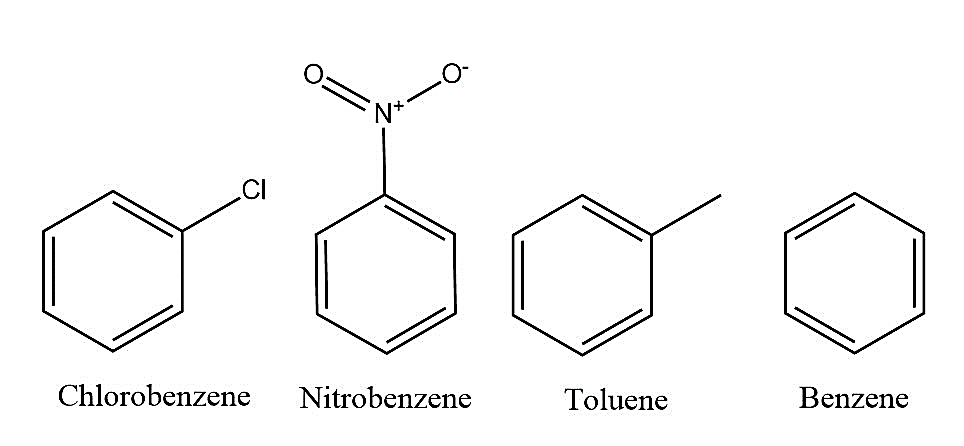
Which of the following aromatic compounds gives a sulphonation reaction very easily?
(A) Chlorobenzene
(B) Nitrobenzene
(C) Toluene
(D) Benzene
Answer
483.9k+ views
Hint: Sulphonation reaction is an electrophilic substitution reaction (ESR). Look at the functional groups present in the given molecules and try to relate their electron-donating or electron-withdrawing effects with electrophilic substitution reactions.
Complete step by step answer:
-Let’s have a look at the options given in the question.

(A) Chlorobenzene- In chlorobenzene, -Cl is the functional group or substituent on the ring. Halogens are highly electronegative so -Cl will withdraw electrons towards itself and deactivate the benzene ring. -Cl is an electron-withdrawing group, so chlorobenzene would not give ESR as easily as benzene.
(B) Nitrobenzene- In nitrobenzene, nitro $-N{{O}_{2}}$ group is the substituent present on the ring. $-N{{O}_{2}}$ is an electron-withdrawing group because nitrogen and oxygen are electronegative atoms. They will attract electrons towards themselves and deactivate the benzene ring. So, nitrobenzene also will not give ESR easily compared to benzene.
(C) Toluene- In toluene, methyl group is the substituent present on the ring. Methyl group shows hyperconjugation effect and so, it is classified as electron-donating group. Methyl group activates the ring and makes it easier to undergo ESR as compared to benzene.
(D) Benzene- Benzene is stabilized with the help of resonance. It has high electron-density and does readily undergo ESR. The presence of electron-donating groups on the ring enhances its ability to undergo ESR. Whereas, the presence of electron-withdrawing groups reduces its ability to undergo ESR.
From the above statements, we can conclude that toluene very easily undergoes sulfonation reactions compared to all other compounds given in the options.
So, the correct answer is “Option C”.
Note: Remember electron-withdrawing groups will always deactivate the ring. Generally, they all are meta-directing but halogens are ortho and para-directing groups. The electron-donating groups are ring activating and ortho and para-directing groups.
Complete step by step answer:
-Let’s have a look at the options given in the question.

(A) Chlorobenzene- In chlorobenzene, -Cl is the functional group or substituent on the ring. Halogens are highly electronegative so -Cl will withdraw electrons towards itself and deactivate the benzene ring. -Cl is an electron-withdrawing group, so chlorobenzene would not give ESR as easily as benzene.
(B) Nitrobenzene- In nitrobenzene, nitro $-N{{O}_{2}}$ group is the substituent present on the ring. $-N{{O}_{2}}$ is an electron-withdrawing group because nitrogen and oxygen are electronegative atoms. They will attract electrons towards themselves and deactivate the benzene ring. So, nitrobenzene also will not give ESR easily compared to benzene.
(C) Toluene- In toluene, methyl group is the substituent present on the ring. Methyl group shows hyperconjugation effect and so, it is classified as electron-donating group. Methyl group activates the ring and makes it easier to undergo ESR as compared to benzene.
(D) Benzene- Benzene is stabilized with the help of resonance. It has high electron-density and does readily undergo ESR. The presence of electron-donating groups on the ring enhances its ability to undergo ESR. Whereas, the presence of electron-withdrawing groups reduces its ability to undergo ESR.
From the above statements, we can conclude that toluene very easily undergoes sulfonation reactions compared to all other compounds given in the options.
So, the correct answer is “Option C”.
Note: Remember electron-withdrawing groups will always deactivate the ring. Generally, they all are meta-directing but halogens are ortho and para-directing groups. The electron-donating groups are ring activating and ortho and para-directing groups.
Recently Updated Pages
Master Class 12 English: Engaging Questions & Answers for Success

Master Class 12 Business Studies: Engaging Questions & Answers for Success

Master Class 12 Social Science: Engaging Questions & Answers for Success

Master Class 12 Chemistry: Engaging Questions & Answers for Success

Class 12 Question and Answer - Your Ultimate Solutions Guide

Master Class 12 Economics: Engaging Questions & Answers for Success

Trending doubts
Which are the Top 10 Largest Countries of the World?

Differentiate between homogeneous and heterogeneous class 12 chemistry CBSE

What is a transformer Explain the principle construction class 12 physics CBSE

Draw a labelled sketch of the human eye class 12 physics CBSE

What are the major means of transport Explain each class 12 social science CBSE

What is the Full Form of PVC, PET, HDPE, LDPE, PP and PS ?




